Erasmus Traineeship Experience in Valencia
Hi everybody!
In this article I will describe Valencia and my experience of doing an Erasmus student traineeship in this city!
Valencia is a beautiful city that is definitely worth visiting!
Upon arriving at Valencia airport, my first advice to you is that you obtain the TuiN card, which allows you to save money on the price of metro tickets in the city centre (it will cost you €2 instead of €3. 90) and to travel from one area to another without needing to purchase more passes (one costs €1). The only "issue" is that you must remember to also validate when leaving the metro, or you will pay the increased price of around 50 cents (this isn't required for the tram, for which you only need to validate on entry). There's also another type of pass, called bonometro. This gives you 10 journeys in a singular zone of the city for a discounted price. The "issue" here is when you want to change zones, you have to buy another pass, or wait until you've used up all the existing journeys to change it.
How's the weather in Valencia?
The weather is typically Mediterranean, mild and humid. The average annual temperature is around 18° C and rainfall is concentrated to the autumnal months, during which it is quite heavy. I was in Valencia from 29-03-17 to 23-05-17 and it only rained on two of those days. As soon as I arrived, I went to the beach and I also took a dip in the sea; even though the beachfront was only assembled at the beginning of May. However, the beaches were quite busy and became more and more crowded.
What were the beaches like in Valencia?
The beaches in Valencia are long and sandy.
The closest to the city centre is La Malvarosa, easily reached via tram or bus (I advise taking the tram, as a bus ticket is €1. 50, which is more expensive than the tram, and it also takes less time, with there being no traffic on the tram lines). The sea, in my opinion, is nothing special. In the mornings it's nice, clean and with clear water.
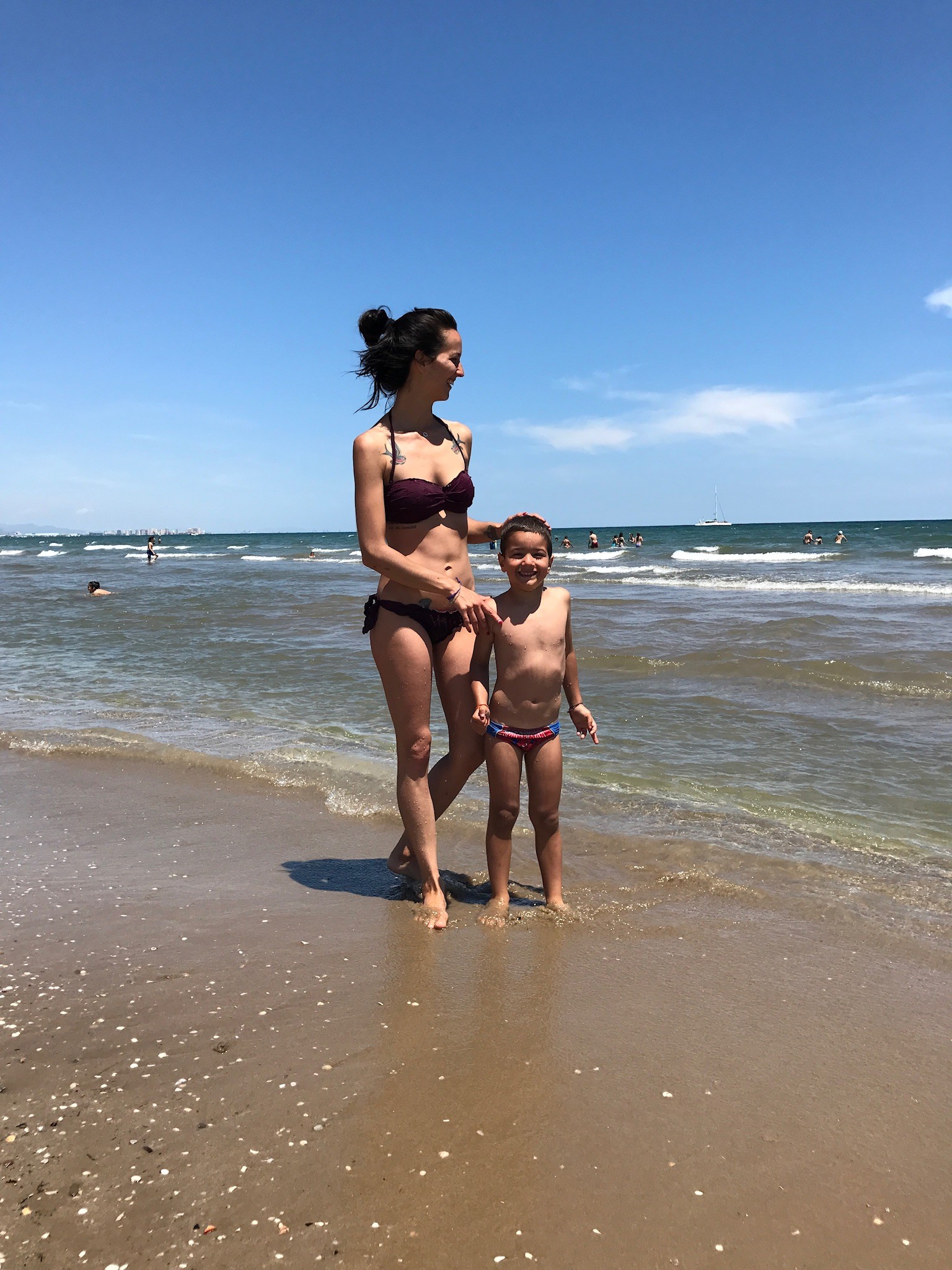
The sea in the afternoons becomes full of little bits of brown seaweed, which is quite annoying.

The beach extends for many kilometres, given that it also includes the Playa de las Arenas and the Playa El Cabanyal. All the beaches are equipped with public showers and volleyball fields, available to all. (Make sure your ball is quite heavy, as it's very windy and a classic Super Santos ball would fly away).
The beachfront is very lovely, full of palm trees, fountains, little restaurants where you can taste an excellent paella valenciana, and small gardens with little carousels (which is very nice for those, like me, who are travelling with a child). The only flaw is that the area near the beach is full of abandoned houses, populated with gypsies. One of my first few days in Valencia, I was with my son in the vicinity of the beachfront and I was looking for a bar to buy a small bottle of water. I heard music and went closer, soon realising that I was amidst a wild mob of gypsies, which annoyed them and they intimidated me into leaving, by throwing firecrackers. It was quite an unpleasant experience. Therefore, I recommended being very careful, on the beach too: never leave your things unattended, there are many thieves that wait for you to move away to go for a swim in the sea and then steal your valuables.
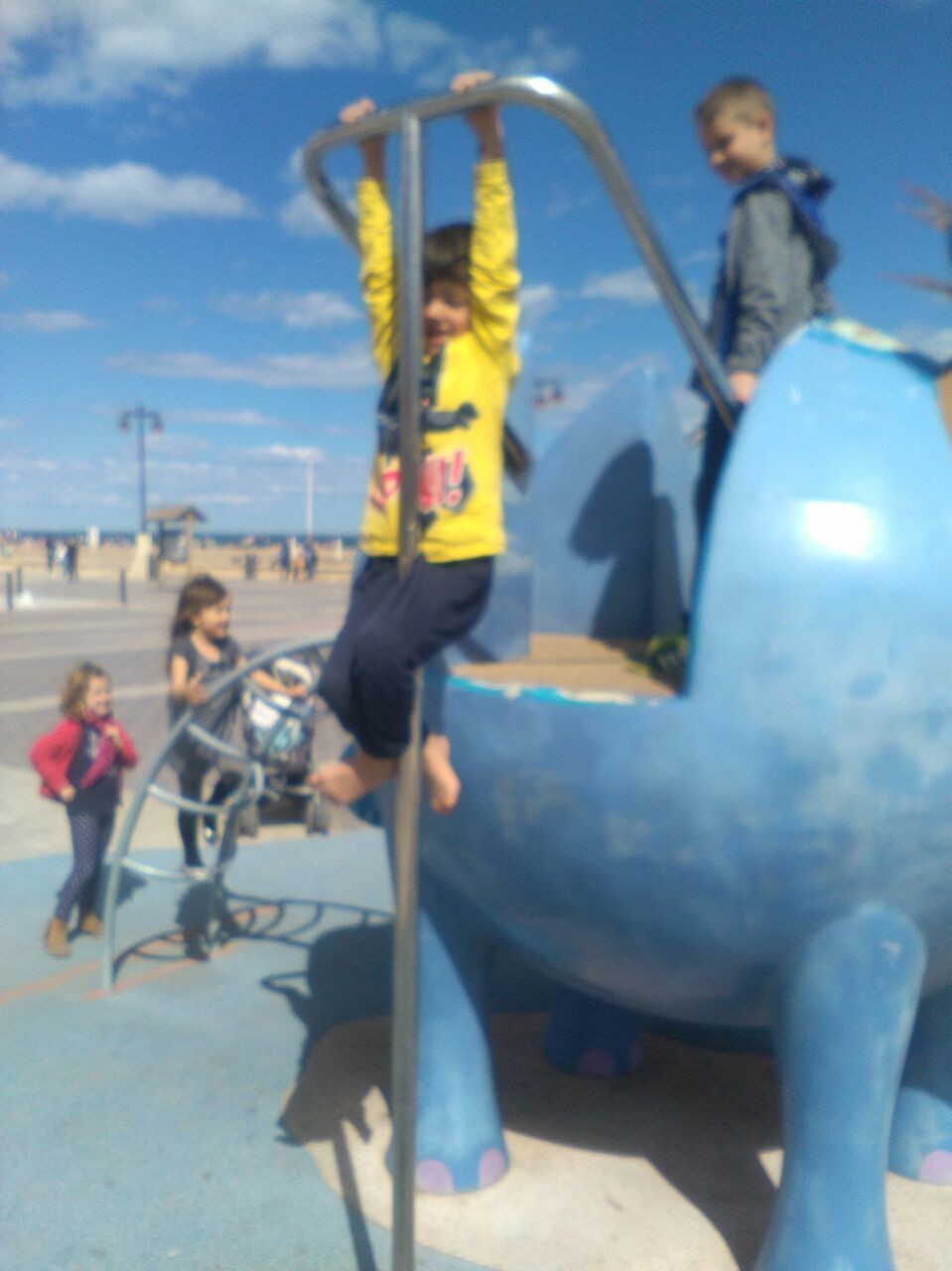
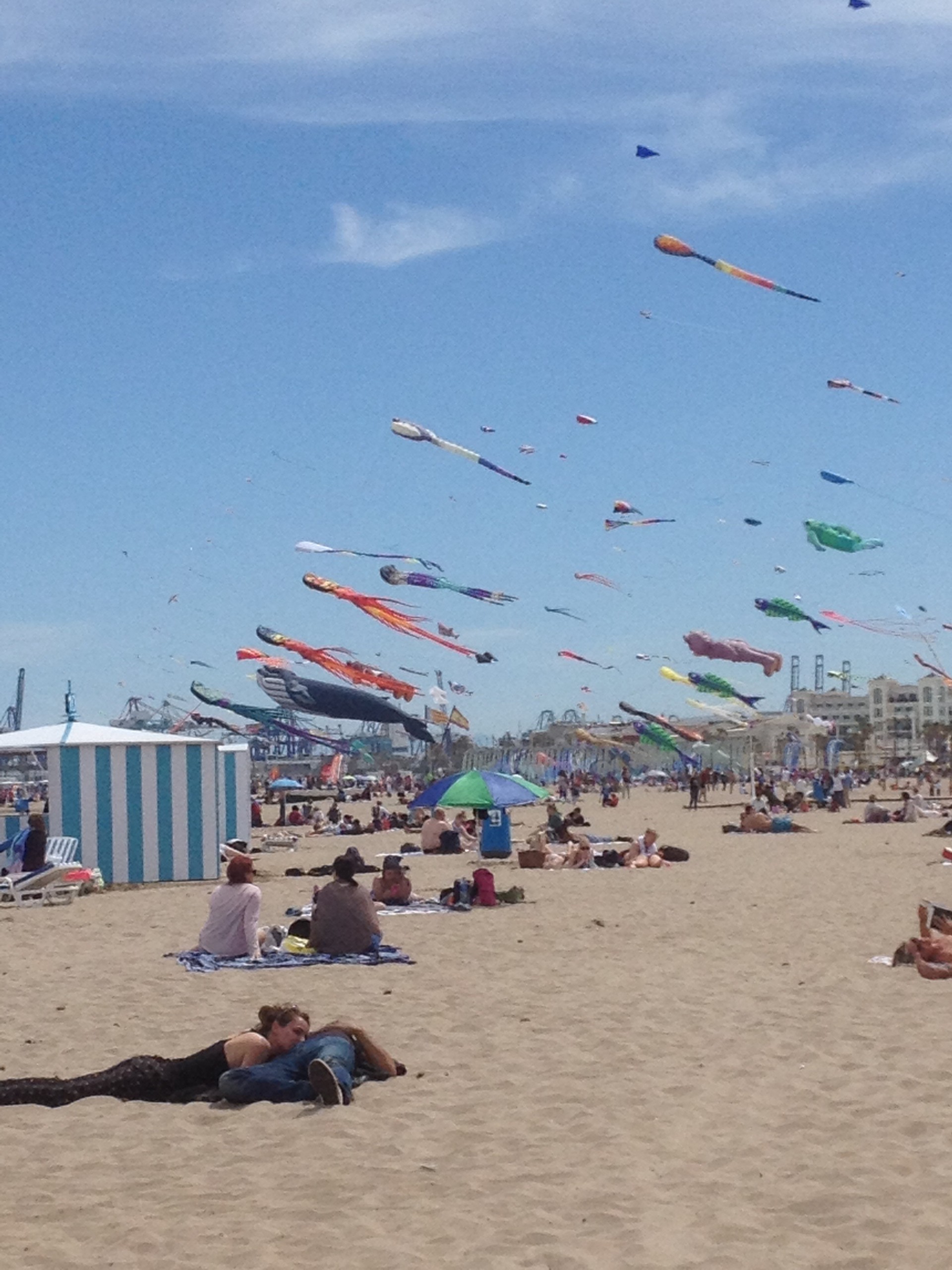
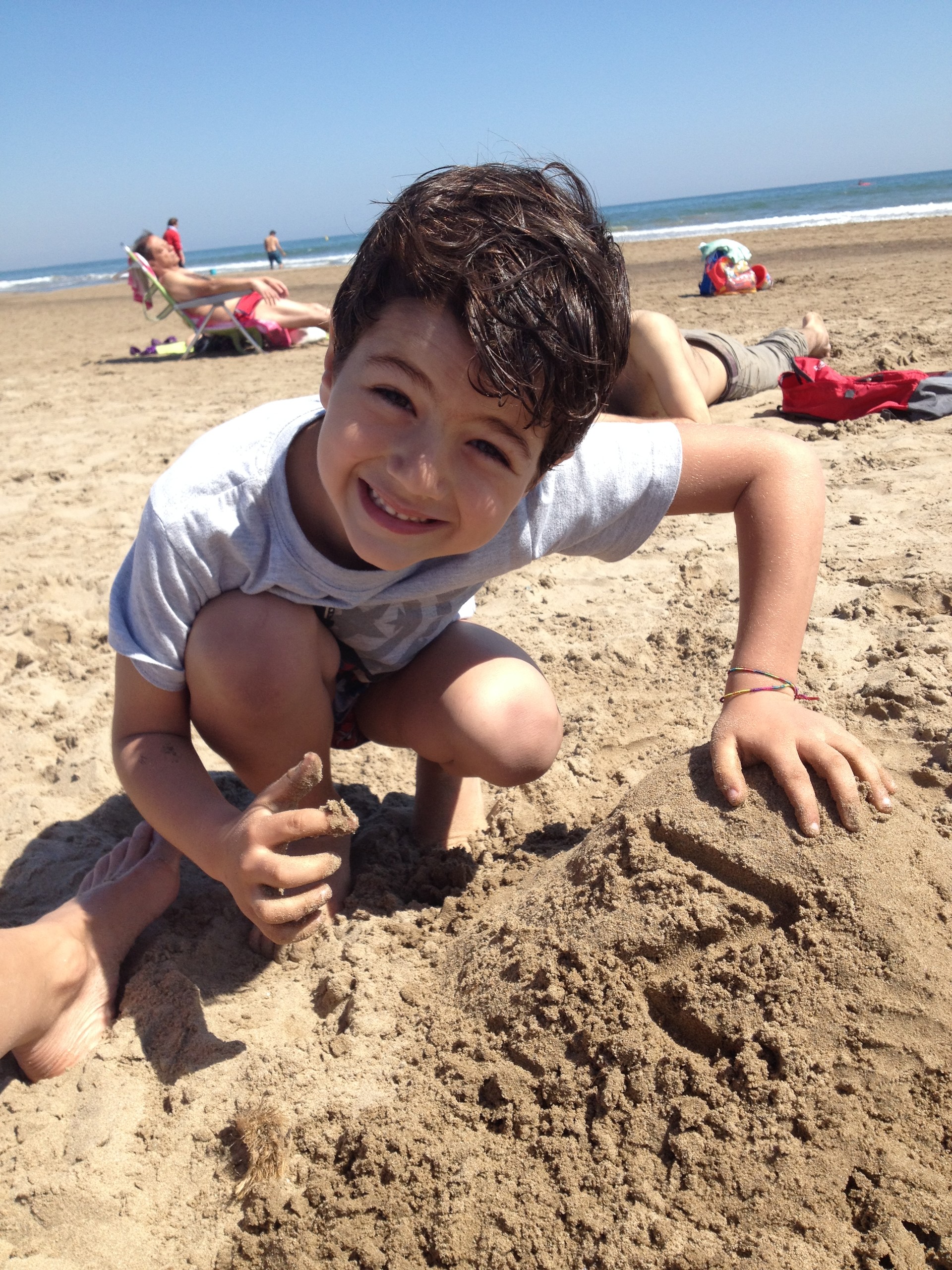
Would you recommend Valencia as an Erasmus destination?
Yes! Definitely in the Spring/Summer, when you can benefit most from the sun and sea! Unfortunately, there's nothing I can say about the system of the University of Valencia, as I had the opportunity to complete an Erasmus traineeship so I didn't attend lessons. If you're interested in doing an Erasmus traineeship and you're a languages or graphic design student, you can contact my employer, Antonio Devis, owner of the company My Language Skills. The company publishes free online books in different languages of the world, as learning resources.
The job of the Erasmus students is to write and publish the contents of grammar books in their native language. My case was different, as the owner needed a Portuguese student and, having no success in finding one, I was assigned to the Portuguese grammar book, as I have a C2 level. The office was located in Godella (a few metro stops from the centre of Valencia) and it's practically the boss's home. So everything was quite informal. Antonio is young and friendly. He asks students to work for 30 hours a week, organised how you want. Theoretically, the work schedule is from Monday to Thursday from 9am to 6:30pm, with a 1 hour lunch break. And if that wasn't enough, being a small office, one also often works from home, which is fantastic, in my opinion.
Is it difficult finding a place to live in Valencia?
For me, it was honestly very difficult to find somewhere to live in Valencia, for two reasons: the fact that I was travelling with my son Pietro and the fact that I was only staying for 2 months (as I had already been in Portugal for 10 months and the maximum length of a study cycle is 12 months, so I couldn't stay there more than 2 months). I started looking for accommodation several weeks before leaving, in various places, (including this one), but the majority requested a minimum stay of 3 months. I began contacting individuals on the website Milanuncios and they also required a minimum stays of more than 2 months or they didn't accept children in their houses. I also had the idea of renting a studio, but the prices were truly exorbitant (€700). For a lower price (€450) you could rent an entire apartment with 3 bedrooms. In any case, for you it will surely be easier finding suitable accommodation at a reasonable price.
The day before leaving, I finally found a house, shared with the owner, a Guatemalan 30 year old woman with an 8 year old son. The rent for the room, which was really small, with a single bed and without a desk, was €225. The situation wasn't perfect, but it seemed to be the only option, after so much searching and I also liked the fact that there was a child in the house, who could play with my son. It was the worst month of my life. The owner was "obsessed" with energy consumption and we couldn't use a hairdryer (I shaved my son's hair so it would dry faster, and I only washed my hair 4 times that month, so I didn't get sick), we couldn't use the oven, or wash our clothes for more than 15 minutes in the washing machine. What is more, they didn't flush the toilet after using it, to reduce water usage and I found their reminders unpleasant.
In addition, whilst I was cooking during the evenings, the son came and turned off the light. During the night he threw the ball bouncing it against the door of the bedroom. He looked at my son Pietro "maliciously", signalling him to keep quiet. Hence I was suddenly in need of a new place to live, knowing that it would be an even more difficult challenge, and after someone tried to rip me off, unexpectedly, I had a stroke of luck, or so I believed, but it was revealed to be the opposite. I found this house, on the fifth floor without a lift, sharing again with the owner, a 23 year old girl from Barcelona, who told me that she had put some money aside and had bought this house. She spoke Italian and was rarely in the house. Everything was going well until, 10 days before my return to Italy, she told me that she would have to go back to Barcelona (a week before my departure) for a month and she didn't want to leave me alone in her house.
This was quite a shock. I tried reasoning with her, explaining that it would be impossible for me to find another place to live at a price that wasn't exorbitant. I swore that I wouldn't throw any parties in her absence, and I wouldn't burn the house down, or steal anything. But there was nothing that could be done. Staying in a hotel would have been way too expensive. I had thought of inter-railing around Spain and I had also studied the itinerary, that I propose to you again. It would be a pass valid for 3 days of transfers, in a month. It would cost you around €200 (including train bookings, that unfortunately are paid separately). The departure would obviously be from Valencia. First leg, the morning: Sagunto. Second stop, the afternoon: Zaragoza. Departure and arrival in the evening in Madrid.
That is the first day of the journey. I would have stopped for a couple of days in Madrid to go to Parque Warner with my son, a theme park for all ages, with all your favourite superheroes. The entry ticket to the park costs around €25 and the second day you can enter for €5 (you buy the tickets for the second day from the shops just before the park exit). For the second day of travelling, I considered a stop-over in Cordoba in the morning, then arriving in Seville in the evening. The following day would be wholly dedicated to visiting this city, then leaving again towards Malaga the next day. After visiting the city, we'd return to Valencia. That is how to make the most of three days of inter-railing.
However, when I suggested this idea to my boyfriend, he thought it was crazy so I chose the simpler alternative, buying another plane ticket and losing the money on the ticket I had already bought for the 1st June. Between me and my son, it was €45 overall. So I bought a ticket for Naples (€75 for the both of us), to leave exactly a week before my presumed departure. Luckily the house's owner gave me some of the money back and the boss of the company where I was working was so kind in letting me finish my work in Italy, so I didn't lose my study grant. In any case, from this point of view it wasn't a good experience and as I've recommended in another article, it's always better to have a contract. If I'd had a contract, the second owner wouldn't have been able to behave as she did. It's also true that, if I had a contract with the owner of the first house, it wouldn't have been as easy to leave, as I did.
How did you organise everything alone, with your son too?
In reality, I'm used to travelling alone with my son. The first journey we took together, he wasn't even three months old. I bought two one-way tickets to Portugal. At the time I was still breastfeeding Pietro and I could fit him in a specially designed baby carrier. So it wasn't difficult. Of course, I had to carry the stroller and luggage by myself, and stop every time he cried, and I definitely couldn't experience the night life. But it didn't bother me. I stayed in Portugal for about a month or so, stopping to greet various friends in the cities of Porto, Coimbra and Lisbon. Then we returned to Italy. But from then, we started travelling, without stopping. At the age of 9 months, I took him with me to London and Prague. At 15 months, I took him to Hurghada in Egypt. At 24 months, he had already done two cruises, on both the Eastern and Western Mediterranean seas, visiting Rome, Palma de Mallorca, Marseilles, Savona, Bari, Santorini, Mykonos, Corfù, Dubrovnik, and any other city that escaped me at the time. Then we lived together for 10 months in Coimbra, and we carried on travelling in that time. We went to The Azores, Salamanca, Paris, Stockholm, Warsaw, Oslo, Bergen, Bucharest, Helsinki, Tampere, Turku, Kemi, Rovaniemi...
Pietro has become a great traveller. He made friends with everyone, he didn't cry on neither planes nor trains. One day he also had two flights, or 14-hour trains, for example, to get to the North Pole. He never complains. He never causes any fuss. He eats whatever is put in front of him and adapts to any situation. He began answering people who asked if I needed a hand with my luggage, that I was quite used to carrying everything by myself. He wasn't even 6 years old, and he already knew how to speak Italian, Neapolitan, Perugian, English, Portuguese and Spanish!
So I had no doubts about us living together alone in Valencia. Unfortunately, the school which I thought I could send him to was full. It wasn't easy finding another. I had to go to a specific office more than onces. Files, documents, photocopies. But I found a school! The closest was 20 minutes by foot from our house, walking at a fast pace. And afterwards, to get to work, it took another 30 minutes and two metro changes. I also had to bring the stroller with me, as they didn't let me leave it at the school. After a few days, luckily, I found a different solution. I started leaving it one of the security chains at a supermarket near my son's school. Thus I was able to avoid lugging an empty stroller around the city.
I thought the school was very good. I had no problems with it. It was a state school, so free. I only paid for meals, which were almost restaurant quality, both due to the dishes served and the cost, which was €150 a month. Usually I pay €50 a month in Italy. The days were from 9am to 5pm, strictly. So I organised my work hours around this. I was definitely lucky to have a job that let me work from home and to make up for any missed hours, at any time.
When I moved to the second house, everything was simpler. The tram stop was a lot closer, and it stopped just outside of Pietro's school in a couple of minutes. We often jumped at the chance, not even getting a ticket. Or we'd walk, which would take around 15 minutes. In addition, after leaving the school, we always stopped by the park near the house, the Parque de Marxalenes, a beautiful and very modern park, christened in 2001, with many rides for children. In fact, it was always crowded. It covered an area of 80 thousand square metres which also consisted of some buildings, like, for example, a bar, two activity centres, one for young people and another for seniors, an abandoned oil factory, amongst others.
A dramatic moment...
However, one of the first days I was there, one of my son's first days at school, I returned from work and the tram crashed into a bus, so we remained stopped for another half hour. I had to go and collect Pietro. It was getting nearer to 5pm and I hadn't the faintest idea of what to do. The only person I knew was the owner of the house, who was working at that time so she couldn't help me. I didn't speak any Spanish which didn't help me explain the situation well! I returned the phone I borrowed and I called my son's school to explain what had happened and to politely ask them not to leave my son alone. Getting them to understand me was very difficult. I arrived at 5:20pm and found my son together with a policeman and the head of the school. I explained again what happened, also showing them photos to back up what I was saying. Everything ended up ok, although I was seriously panicking at the time, being very worried for my son. I remember also really wanting my boyfriend to be there, whom I'd met whilst in Portugal, he had helped me with Pietro on various other occasions. Luckily, it was the only small inconvenience, and I overcame it well.
What's there to see in Valencia?
Valencia is wonderful! There's so much to see! You could take a long walk through the Turia park, built on the dried-up riverbed of the Turia river, that runs through the whole city. For me, being there with my son, it was spectacular. We spent entire days there. The park was well looked after and had many facilities. There were small fields for volleyball, basketball, football, so many rides for children, little cafes, water fountains (so you didn't have to keep buying bottles of water, we refilled ours whenever needed using the various water fountains). In total, there are 18 bridges to be admired, full of history, and along the river banks you can catch sight of many of the city's monuments.
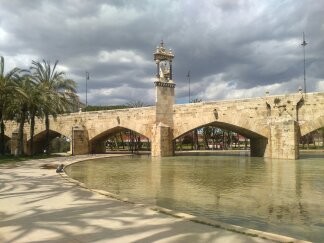
Here, for instance, in the proximity of the Serranos bridge, the magnificent Serranos Tower, one of the 12 gates used to cross the ancient walls of Valencia; a powerful symbol of the grandeur of the city's architecture. Being located in the north of the city, it was usually used as passage by those who came from the mountains, the so-called "highlanders", or "serranos" in Spanish - from which its name derives. Built between 1392 and 1398, it was declared the national artistic monument for it's great aesthetic value. Therefore you definitely must pass by it!
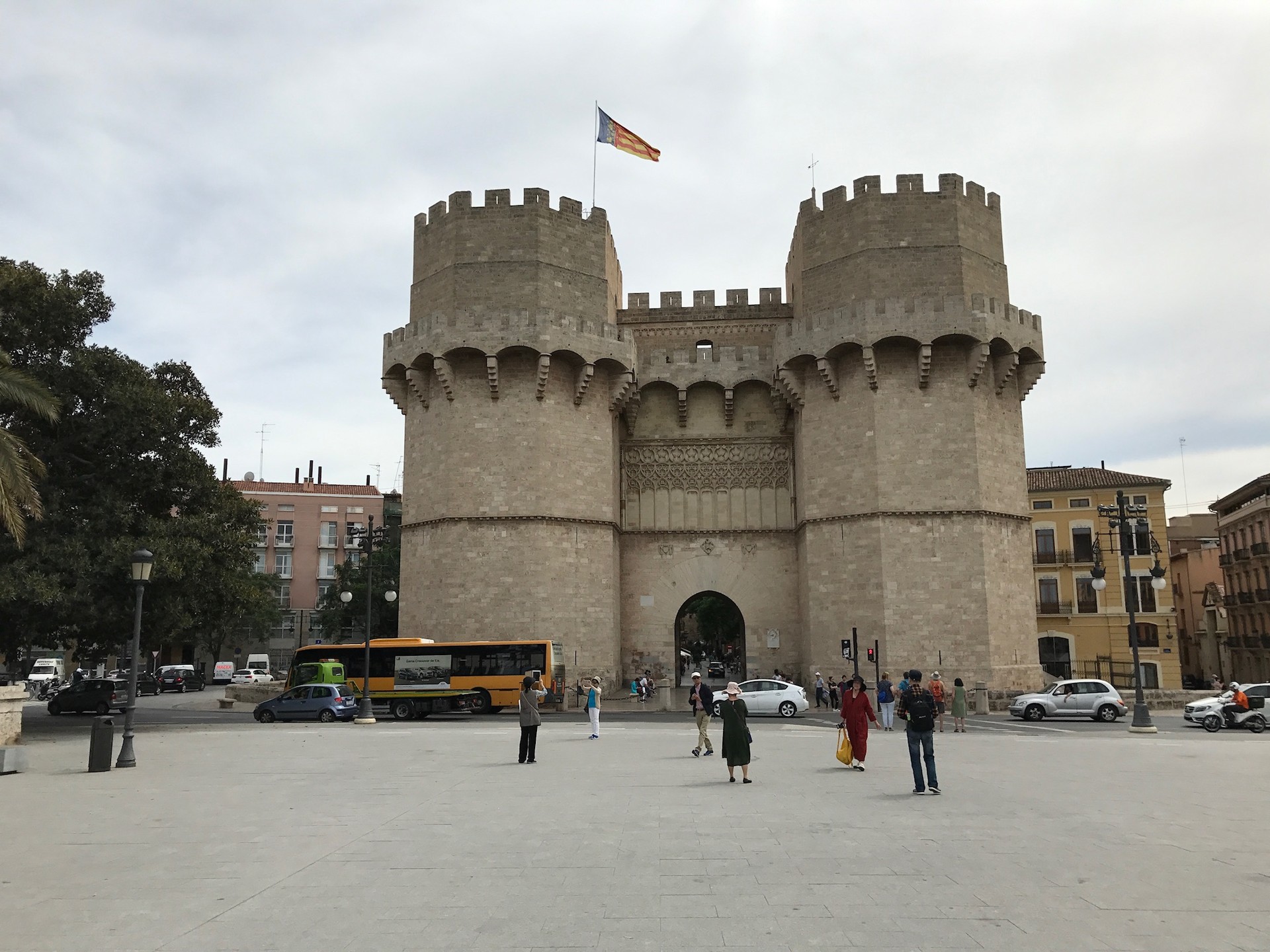
Also, continuing on your long walk through Turia park, you can appreciate the many species of different plants. Look at the trees in these photos, they're quite unusual!
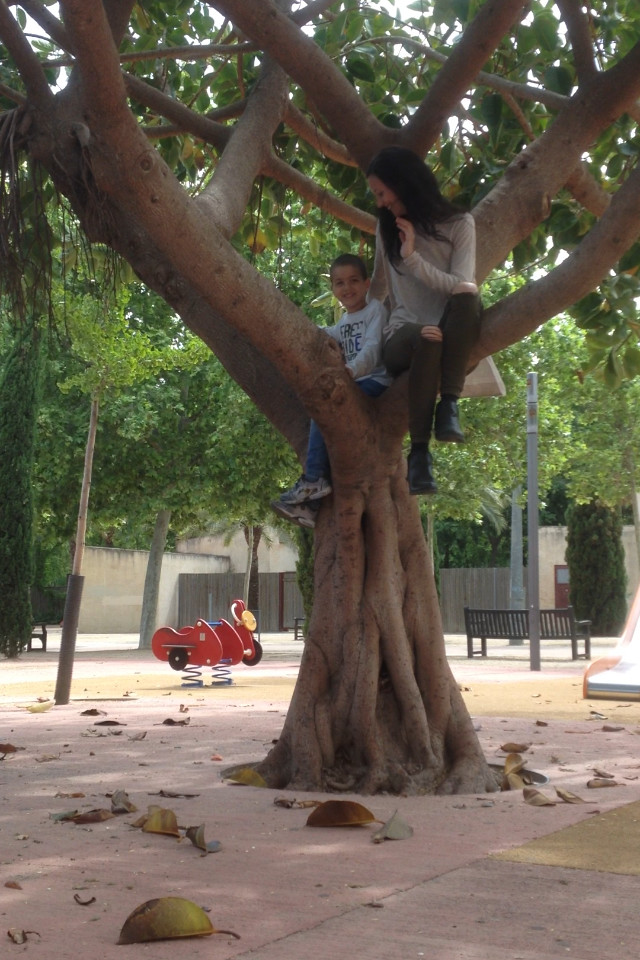


The park expands over 9km that can be easily walked, or cycled if you prefer, on the specific bike paths. You can see for yourself in the photo of the poster below.
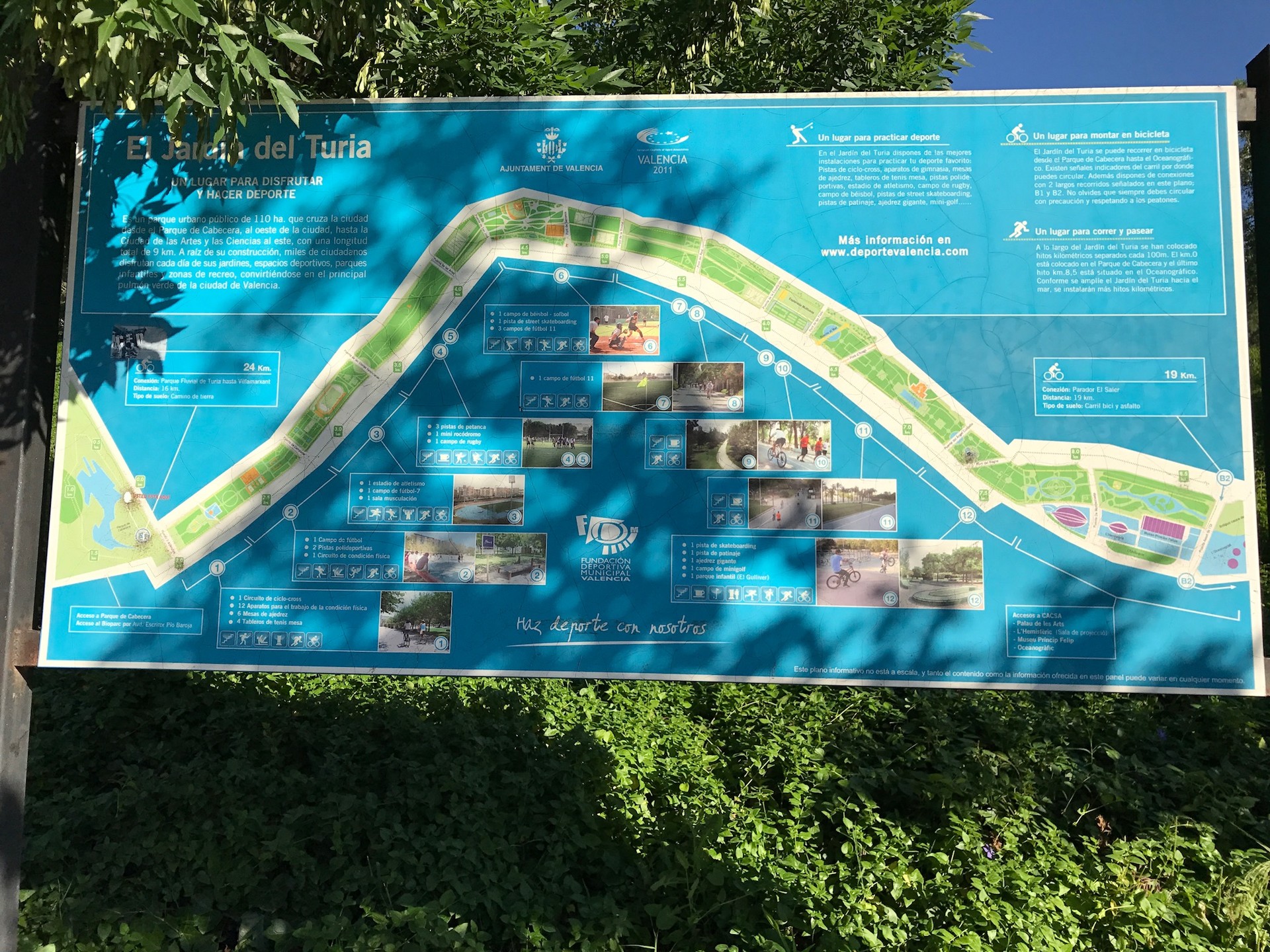
As well as the recreational and athletic areas, you'll also find many romantic little corners in which you can lose yourself. Proceeding from the northwest of the city, you'll pass through the Parque de Cabecera, that within it has a big lake, which is truly lovely. I spent a whole day there with my son, equipped with sandwiches, towels and sun cream. If you don't want to make your own sandwiches, there's a Burger King at the front of the park, where we ate dinner. If you have kids, the park has a very fun slide for children up to 12 years old.
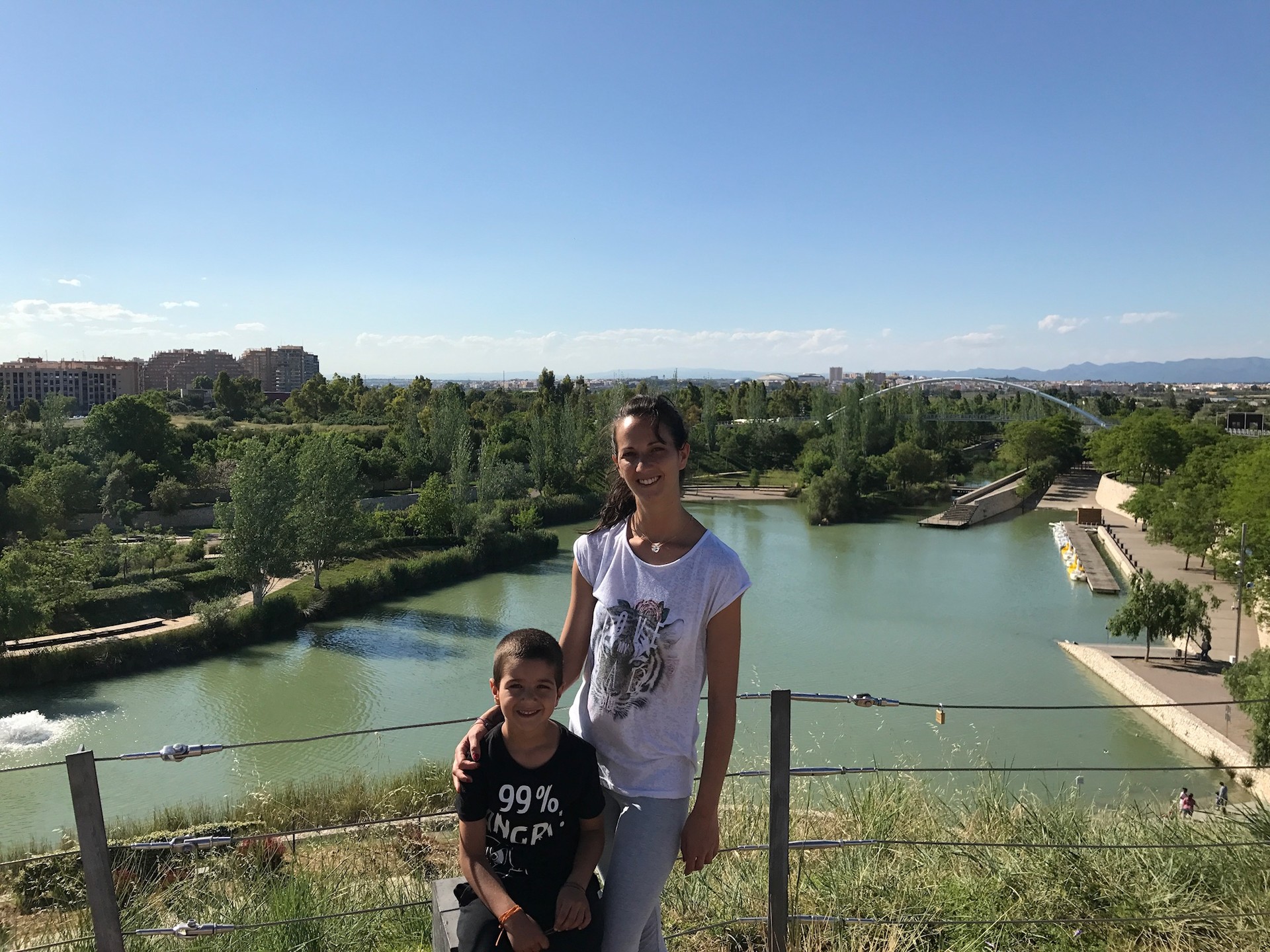
Straight after that, there's the Bioparc, a recently-built zoo, replacing Valencia's old zoo. The entry ticket costs around €23, but it's easy to find discounts (like 2 for 1), so look out for them beforehand if you are going to go. I went there to take my son, otherwise I wouldn't have bothered, having already been to dozens of zoos. Perhaps Pietro wasn't all that interested either, honestly. We had already walked round the whole park after one hour. In my option, there weren't that many animal species. There were lions and cheetahs, but no trace of pumas or tigers. There were various types of monkeys, elephants, giraffes, zebras, ostriches, rhinoceroses, tortoises, meerkats (very cute, but they seemed to be going crazy in their small habitat), hippopotamuses, a lone hyena (poor thing, it was going back and forth as if it was demented; it looked like it wanted to nothing more than to jump out and tear us to pieces), various birds, flamingos (that were very beautiful), warthogs, and many other little animals. See the next photo for the meerkats!

The gorilla made an impression given how he was eating. He looked like a human being, as you can see in the following photo.
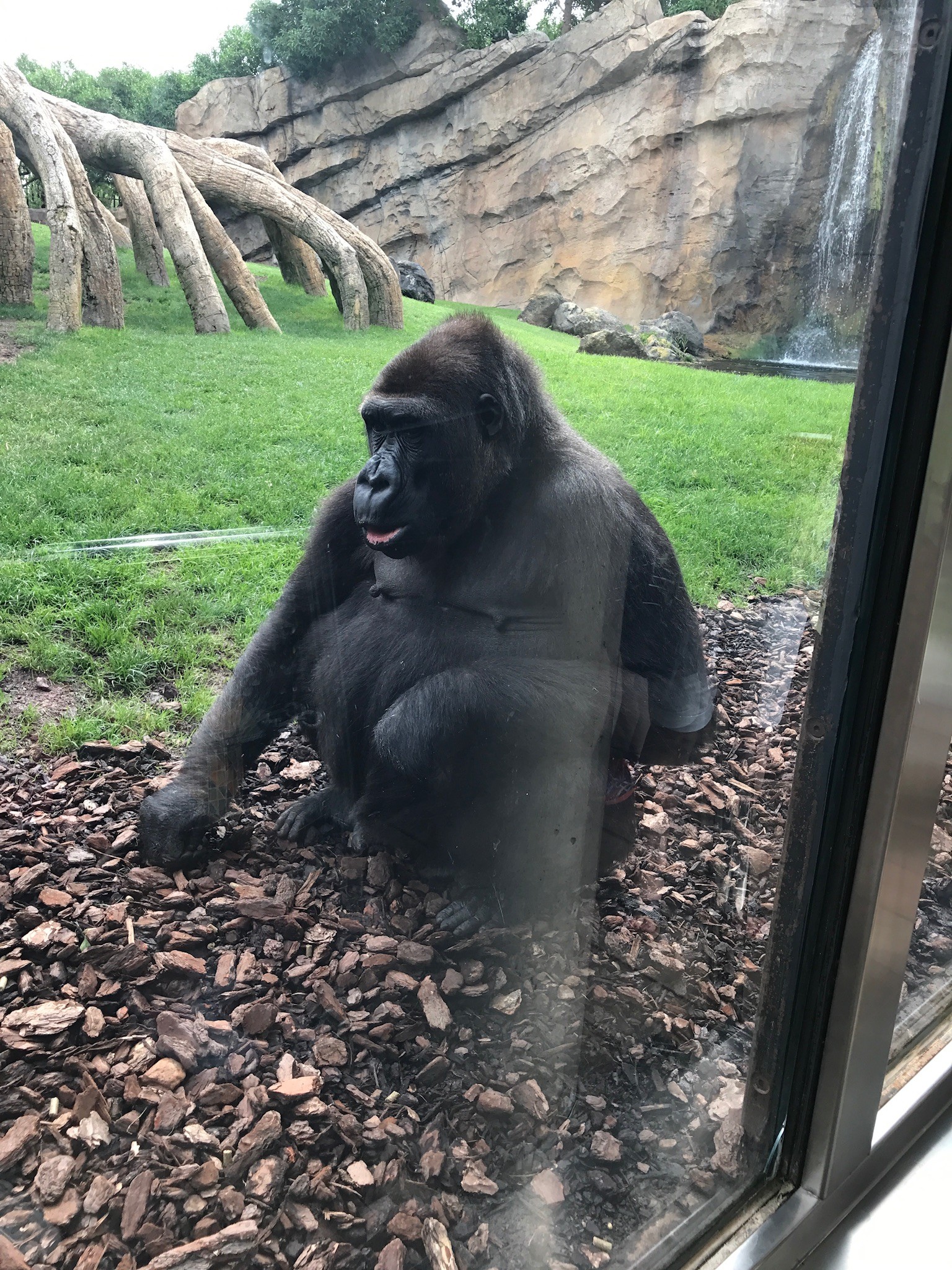
The thing that probably fascinated me the most, really because I had never seen it before, was the size of the Baobab, a majestic tree originally from Africa. There's a picture of one below, together with a beautiful elephant!
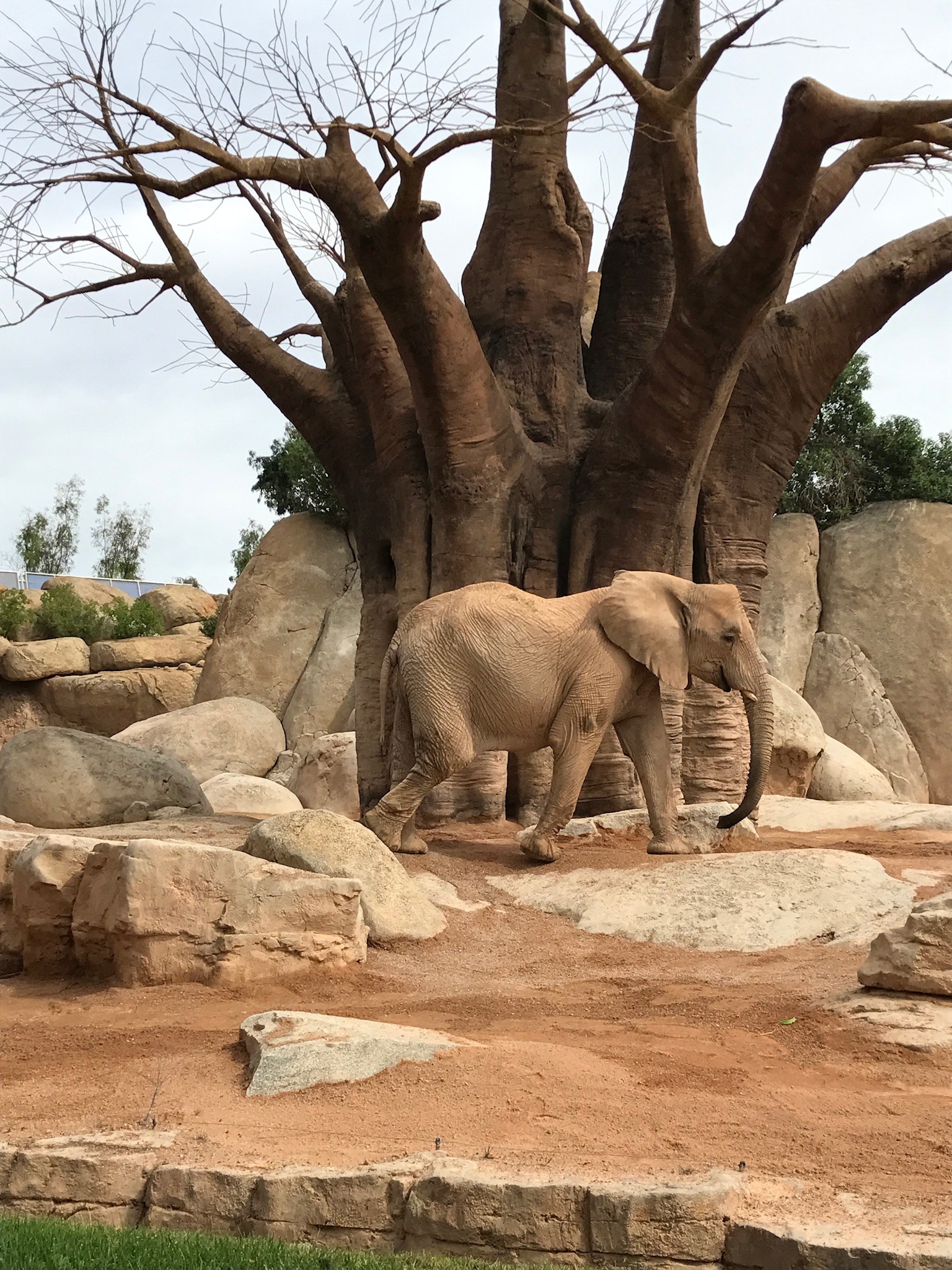
There's a pretty decent show in which they display various species of flying animals, porcupines and other animals. Everyone seemed enthusiastic, personally I didn't share any of their enthusiasm; but as I've said, I've seen a lot of things like this. In reality, the Bioparc should aim to encourage respect for animals, raising awareness as much as possible, be it directed towards adults or children.
Continuing through Turia park, you will find many interesting areas, such as Gulliver Parc, adored by children, but also appreciated by adults. I've spent endless hours there with my son. Entry is free and the park is open from 10am to 8pm, every day, all year, except for August, when the opening hours are from 10am to 2pm, then 5pm to 9pm. Keep that in mind! It would be such a shame to go and find it closed.
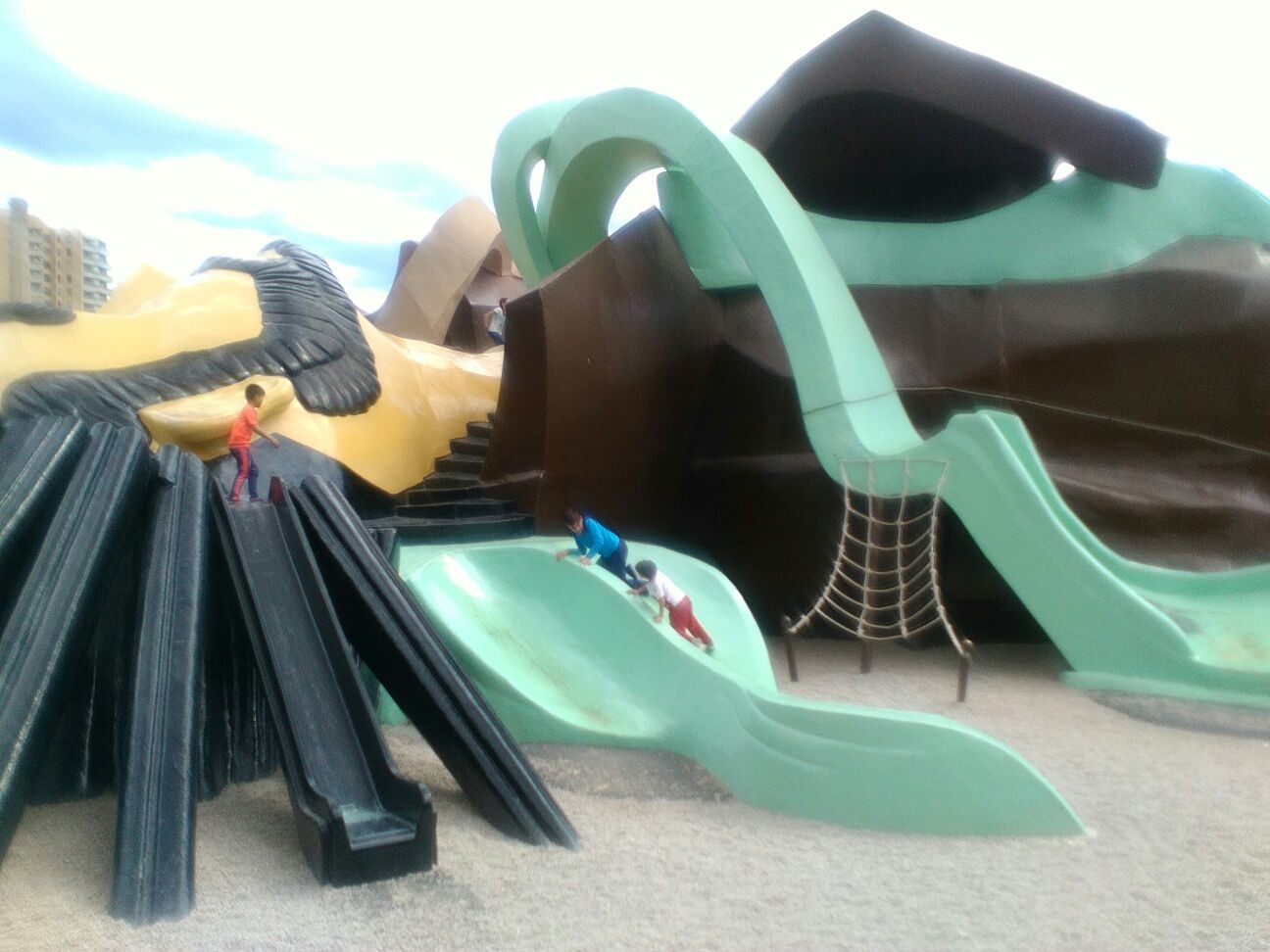
It can be said that the Turia gardens connect the Bioparc's African savanna with the underwater world of L'Oceanogràfic (the largest aquarium in Europe) and with the spectacular opera auditorium (beautiful in the evening, when it's lit up). L'Oceanogràfic is part of a larger collective, that takes it's name from the Ciutat de les Arts i les Ciències (City of Arts and Sciences), of which the auditorium also makes a part. The aquatic parks covers an area of 100 thousand square metres and recreates the most diverse marine environments that exist on this planet. That which has the most appeal is surely the 70 metre long underwater tunnel, walking through it will make you feel like you're at the bottom of the ocean, amongst sharks, rays and a large variety of fishes. You'll also be able to admire walruses, belugas, dolphins, Humboltd penguins, common seals, ducks, swans and numerous birds, including flamingos and the scarlet ibis. Within the park, you'll discover three restaurants, all very good. I advise stopping to eat in the one that is underwater, which is really picturesque! For children up to 3 years old, entry to the park is free; for children aged between 4 and 12, handicappedpeople and over 65s, it costs €21; and for everyone else it's €27. 90. A complete visit would last around 4 hours, but obviously, it really depends on the degree of interest and motivation. The park is open every day, from 10am to 7pm ish, according to the season.
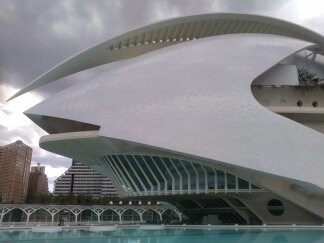
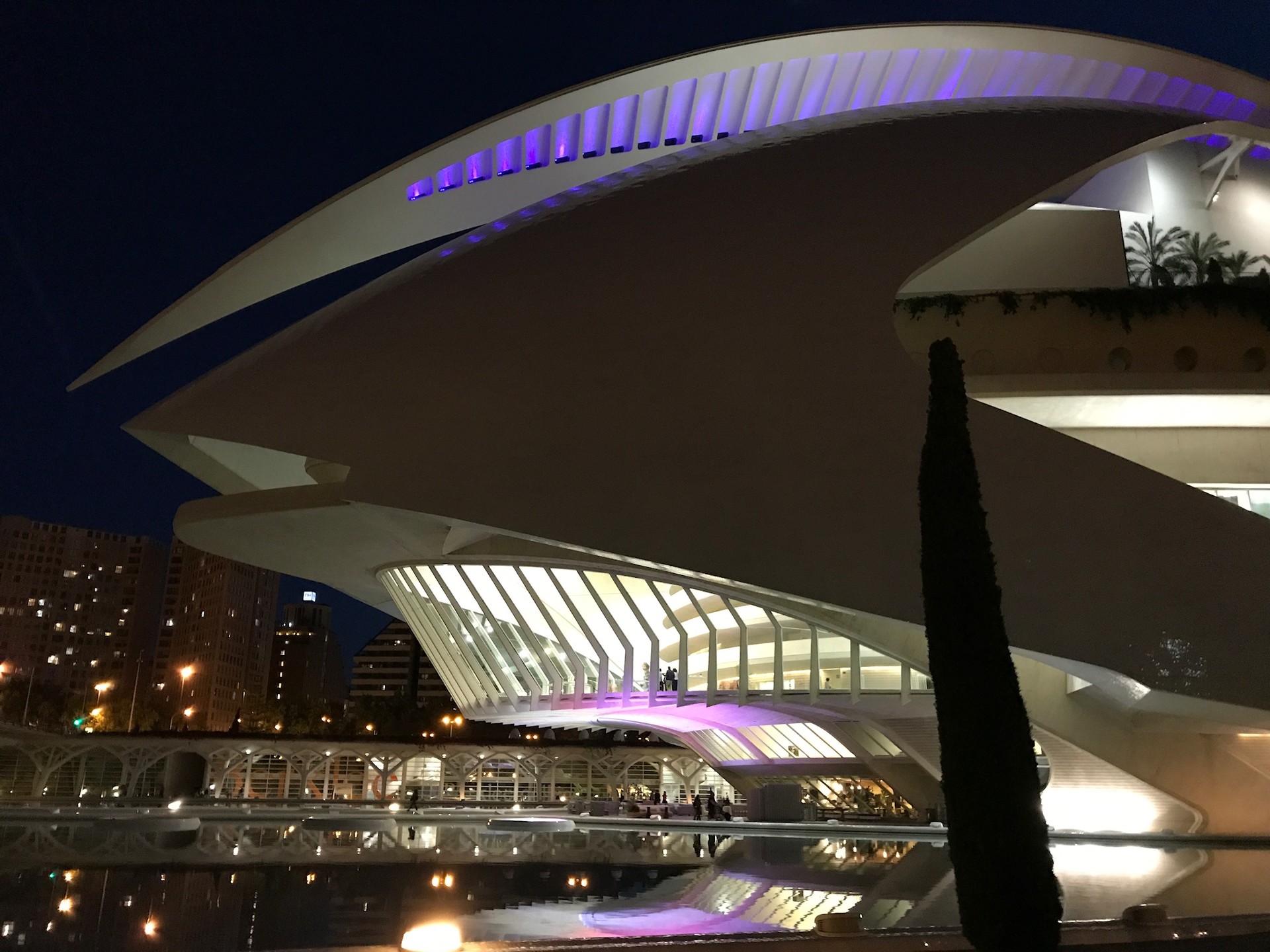
Besides the Turia Gardens, you can also visit: the Royal Gardens, dating back to the Islamic reign in Valencia (11th Century); the Botanical Gardens founded in 1567 by the University of Valencia, for growing medicinal herbs; the gardens of Ayora, Monforte, Hesperides; and many others.
Walking through the streets of the city centre, as an alternative route, you can also see the Basilica de la Virgen de los Desamparados, the main post office building, the Lonja de la seda (the Silk Exchange, the headquarters of Valencia's Royal Academy of Culture, a Gothic-style building that became a UNESCO World Heritage Site in 1996), the Antiguo Convento del Carmen, the Plaza de l'Ajuntament, the Plaza de Toros, the Torres de Quart, the Plaza de la Reina, the Plaza de la Virgen, the Church of Saint Nicholas, the Umbracle, and finally (this list is in no particular order), Valencia's beautiful Cathedral, as depicted in the following photo.
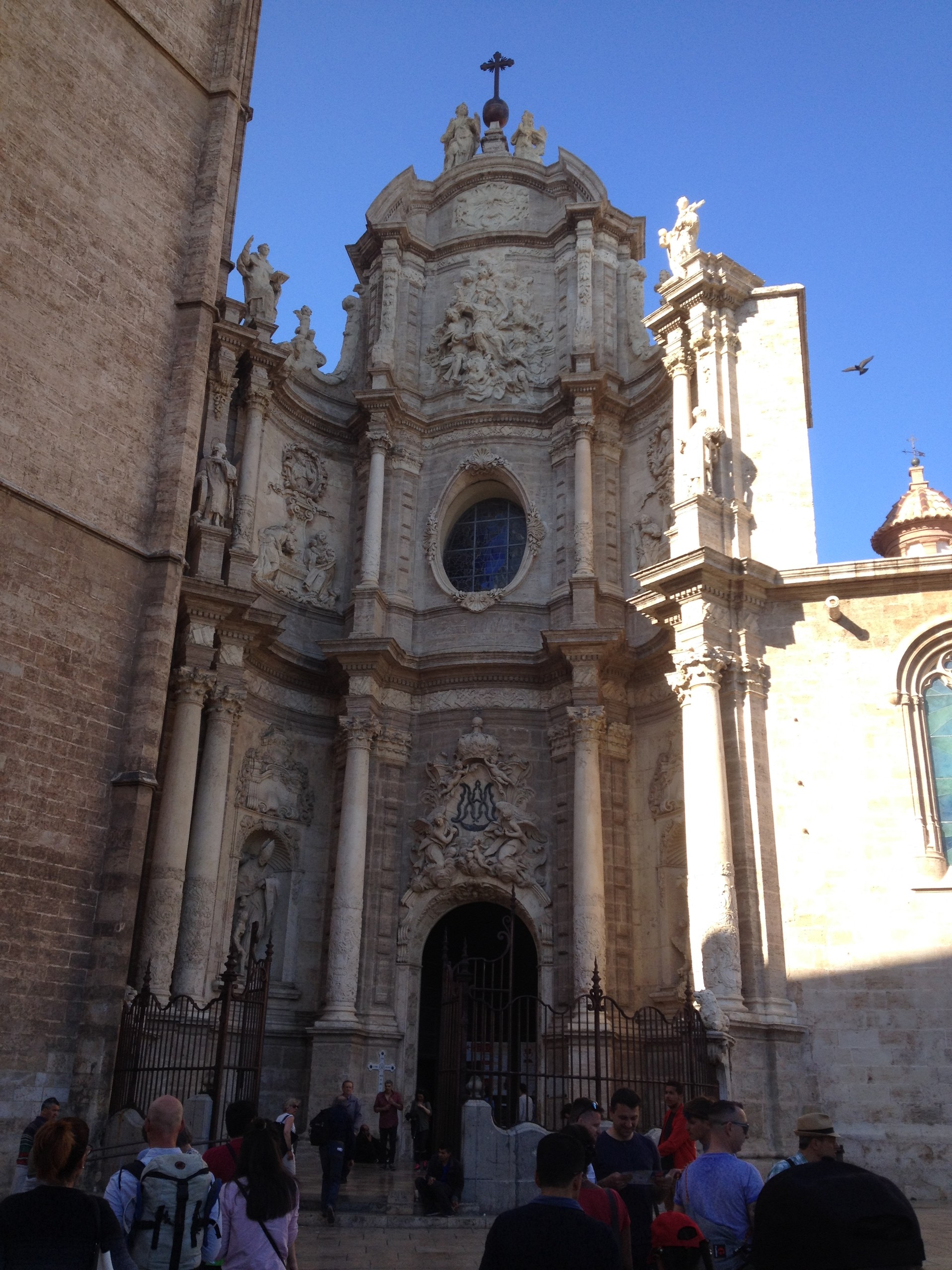
Built in the 13th century on the ruins of a Roman temple, which in turn was built on an Arab mosque, it clearly doesn't have a singular style. Now looking at the three entrances, you can observe the differences in style. The main gate is clearly Baroque. The Gate of the Apostles has a Gothic style and the Almodaina gate, which overlooks the Archbishop's Palace, has Romanesque impressions. The interiors are simple and harmoniously-designed. The back of the apse is painted with a beautiful starry sky. The most important parts to visit are the museum and the Chapel of the Holy Grail. The Micalet tower is also very beautiful, which overlooks the cathedral, from which you can enjoy spectacular views of the best part of the historical centre, of the countryside, and of Valencia's beaches. To get to the top of the tower, you'll have to climb a spiral staircase of 207 steps, along which you will find three rooms. The first, only two meters wide, was used to accommodate people seeking asylum. The second was the room for the bells and in the third, which is the equivalent of the terrace, you will find no less than 11 bells, each with its own name. The tower has an octagonal floor plan and was designed by Andrés Julià, in an evidently Gothic style. You can visit the Cathedral and the Tower every day, from 10am to 6pm, for only €3.
Furthermore, in Valencia, there are many museums to visit, like the Patriarca Museum, the Almoina Museum, the Illustration and Modernity Museum, the National Museum of Ceramics, the Prince Felipe Science Museum, the Ethnological Museum, the Fine Arts Museum, the Toy Soldiers Museum, the Municipal Museum of Natural Sciences and the Museum of Prehistory of Valencia. Another must-visit place is the Central Market, an impressive building in a Modernist style, dating back to the beginning of the 20th Century. The structure is made of iron, its stained glass windows enhanced by sunlight, its ceramics and glazed tiles will make your jaws drop. Inside you will find all kinds of food, from fish to meat, from sliced fruit and vegetables. The opening hours are from Monday to Saturday, from 7:30am to 2:30pm.
A little further from the centre you can find the Albufera Nature Park, easily reached with the El Palmar bus, which takes around 30 minutes. It is a very humid lagoon area, rich with a variety of flora and fauna, but also very important and known for rice crops, providing an influential source to the local gastronomy.

What is there to see in Valencia's surroundings?
Valencia is in a rather advantageous location, in Eastern Spain. From here, it's very simple getting to other historical cities or places with more nature. The local streets are well-paved and allow easy travelling, also, the public transport network is very efficient.
The cities around Valencia are united by a long historical past characterised by the centuries-old presence of the Arabs, permanent traces of their culture have been left in the numerous monuments that you can visit.
Amongst the several places I recommend visiting, if you have any free time, are:
- Sagunto: an ideal city to spend a day dedicated to the sea and the local history. You'll enjoy the beautiful Citadel and the Roman Theatre.
- Peñíscola: it boasts a thousand-year old history dating back to the Phoenician civilisation. Here you can appreciate amazing fortified Castle and have a beach day at "Playa Sur".
- Cullera: the Albufera Park here has many paths for enchanting nature walks, and the historic centre is rich with monuments and very lovely churches.
- Elche: famous worldwide for its palm trees, it has also been listed as a UNESCO World Heritage Site.
- Cuenca: known for the wonderful "Ciutad Antigua", easily reachable by foot via the bridges.
- Buñol: where you can participate in the famous "Tomatina" festival, which consists of a city-wide tomato fight throughout the streets.
- Benidorm
- Alicante
- Castellón de la Plana
- La Vall d'Uixó
- Teruel
- Morella
- Gandia
Finally, don't forget the "Sierra Calderona Nature Park", the "Puig Monastery", and the "San José Caves", a natural wonder, within flows a very long underground river, navigable by means of small boats.
What's the food like in Valencia? What are the main dishes and drinks to try?
The food in Valencia is honestly very good!
Obviously, the most well-known dish is paella valenciana, a symbol of Spain's culinary excellence, originated from the Albufera area (which I have recently mentioned). In contrast to standard paella, which is made with fish or meat, the Valencian version is cooked with chicken and rabbit meat, snails and mangetout. The rice is boiled in a broth in which the meat is cooked, so the flavours are entirely preserved. It has a very strong and authentic taste. Tapas are also very popular, which you can eat in the so-called "taperias", and they consist of a series of appetisers, mostly served warm, which can be incredible and very well-prepared. Bocadillos (small sandwiches) are also very tasty, and pinchos (a type of canapé).
Amongst the drinks, you must definitely try orxata de chufa, a delicious tiger nut milk that is very sweet, and made from a very strange plant that only grows in this area. I don't recommend buying the "extended shelf life" version sold in supermarkets. Instead, try one sold from one of the Mon Orxata carts that can be found at several locations throughout the city, for example near L'Oceanographic. The Spanish usually dip their "fartons" in their orxata, very spongy, long and narrow pastries, covered in icing sugar.
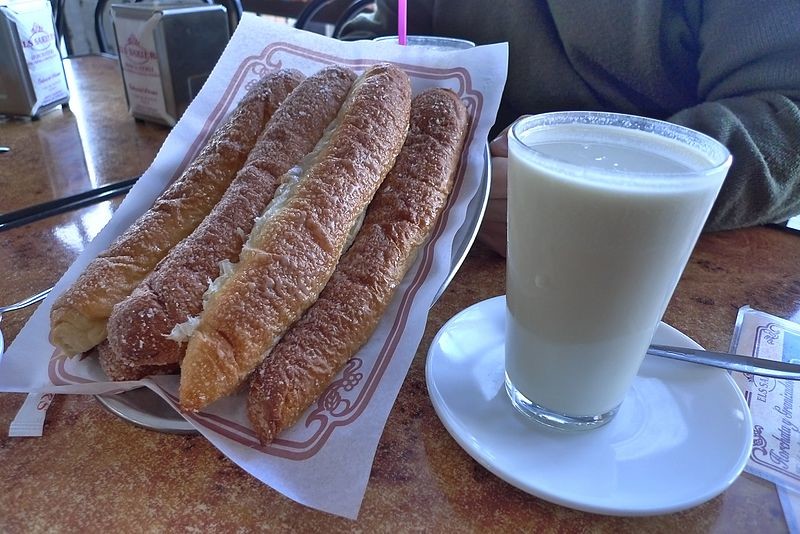
Personally, in Valencia, I was quite dedicated to the care of my body and to my and my son's health, preferring to eat at home. We'd eat lots of vegetables and legumes, lots of fruit, a few sausages, a little pasta, a little meat, lots of fish, using only steamed or grilled cooking methods and avoiding completely salt. In any case, the early days I had the opportunity to eat in various places, which I will now list:
- Spacca Napoli is a very good pizzeria, where the pizza is definitely well-made. It's managed by some nice Italian people and it's very welcoming. Here you can have an excellent Neapolitan pizza for a decent price (also the pistachio cheesecake is very good for a dessert)
- As an alternative, a cheap place to go with friends and try little sandwiches would be 100 Montaditos, which offers good quality bread that's always warm and crunchy, as it's baked once the customer makes the order.
- La Paz is a restaurant located along El Cabanyal beach, with show-cooking and fresh, good quality food. For starters we ordered delicious clams and grilled octopus, a pre-made fish paella and an amazing chocolate cake, a bottle of fruity house white wine and a bottle of water. Between two adults and a child, we spent €70, which seemed quite a fair price to me.
- Another highly-recommend restaurant is La Perla, on the beachfront. We tried paella made with pasta instead of rice, called "fidegua", we drank some lovely fresh wine called "penascal", and concluded the dinner with a bowl of strawberries and cream; I don't remember exactly how much we spent, but it was no more than €30.
- El Forn del Carmen is an amazing small local restaurant, but very lovely nevertheless. It offers paella of the highest quality, which must be directly ordered at least 4 hours in advance, as it's prepared with fresh ingredients purchased especially.
- If you want to eat something besides paella, then try Hansel & Crepel, a very welcoming local restaurant with very friendly staff. They offer a very wide variety of delicious crepes, sweet and savoury, at really competitive prices.
- Otherwise, you can go to Mavalà for an excellent piadina romagnola.
- Then again, a good option for a fast, light and cheap snack could be begreen Salad Company, but don't be too snobby, as the service isn't of high quality (the waiters are practically non-existent and the plates/cutlery are plastic).
- Finally, within the Central Market, there are places prepared to cook for you using the food you have just bought, with a small additional charge.
Where would you recommend for grocery shopping in Valencia?
My preferred supermarket was Mercadona, with convenient prices and a wide range of products. Unfortunately it opens at 9am, like the majority of supermarkets, but it stays open until 9:30pm. (it's closed on Sundays). It's equipped with lockers and chains to attach bigger objects. I used to leave the stroller attached to the security chains there after taking my son to school, so I wasn't walking round the city with an empty stroller, as I was on my way to work. I recommend trying their muffins: both the chocolate muffins filled with white chocolate, and the sponge cakes filled with chocolate sauce (which tastes even better than Nutella... and this comes from a great lover of Nutella! ). Also the pastries are very good, big and small, glazed or not. I had these for breakfast, freshly baked, every morning with a half-litre bottle of orange juice (for €1. 80), freshly squeezed by me, thanks to a special machine in the supermarket, which allows the customer to squeeze oranges instantly, filling half-litre or one-litre bottles.
Suggestions for Valencia's nightlife?
Having brought my 5 year old son with me, and having left a boyfriend in Italy, it was not an Erasmus experience in every sense: my evening outings were few and certainly different from what yours would be. So, I can't give you much advice about the nightlife, but I imagine it's very lively, indeed I know this for sure, thanks to the stories of the guys who worked with me! In any case, it's well known that the Spaniards are party-animals.
When I lived in Campanar, it was difficult for me to go out at night as it was a quite isolated area. Every now and them I took my son to the playground in the Nuevo Centro shopping centre, until about 9:30 pm, where there were the pogo-sticks, inflatable Minions, bumper cars, adventure trails and many other games. In the shopping centre there are so many shops (you can find: Zara and Zara home, Women's secret, Intimissimi, Imaginarium, Pull & Bear, Prenatal, Calzedonia, Yves Rocher, Super Nails, Tezenis, Ale-Hop, Bershka, Benetton, Foot Locker, Stradivarius, Mango, the pharmacy, phone centres, etc. ), bars (Fika Coffee & Food, El Gran Cafè), and restaurants (100 Montaditos, McDonald's, La Tagliatella).
When I moved to the second house, near the Marxalenes park, I went for drinks with my work colleagues. We stopped for a glass of sangria under the Torres de Serranos, and then continued to the Barrio del Carmen, a maze of streets full of shops and cafes, where the night is transformed by this fantastically fun spot. There are many bars and clubs, such as Bounty and Latex. Calle Caballeros is the main street of Valencia's nightlife. The most popular bars are Ghecko (Afro-Asian), Cafe Bahiano (Brazilian) and Cafe Negrito, perfect for fans of soft-rock music, located in Plaça del Negret, a square full of trendy clubs. Also Plaça de la Mare de Déu is very popular with young people and the main bars here are Cafe Saint Jaume, Cafe de las horas and Jimmy Glass Jazz Bar.
As for the university district (Blasco Ibanez, Alameda, Aragon ), the nightlife doesn't begin before 10pm and you can start the evening off with some delicious tapas at the very popular Sidreria El Molinon. Another trendy neighbourhood, lately very favoured by young people, is called Ruzafa, full of cafe/bars and bookshop bars, like Ubik Cafè and El Soho Terrace (chilled music). At 2am the bars have to close and everyone relocates to the clubs (one of the busiest is the Biscuit Club).
Any other useful tips for us?
I leave you with some phone numbers which could be useful in case of emergency:
- A&E 012
- Guardia Civil 062
- Local police 092
- National police 091
- Radio-Taxi +34 96 370 33 33
- Tele-Taxi +34 96 357 13 13
- Fire Brigade 080
- Italian Embassy +34 96 321 72 34 or +34 672 770 743
All that remains is to wish you a good trip and great stay in Valencia!
Photo gallery
Content available in other languages
Share your Erasmus Experience in Valencia!
If you know Valencia as native, traveler or as exchange student... share your opinion on Valencia! Rate different characteristics and share your experience.
Add experience →




































Comments (0 comments)